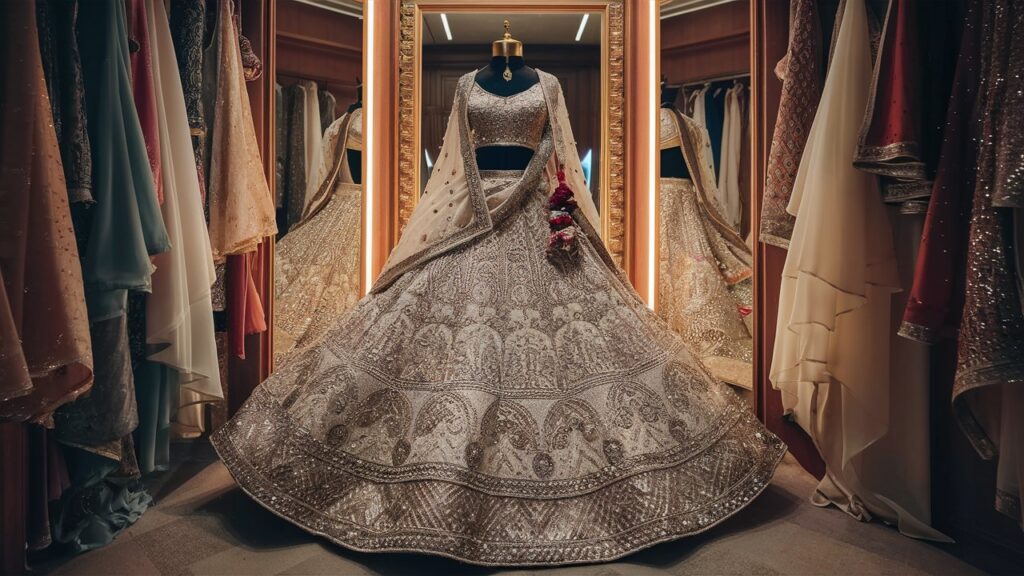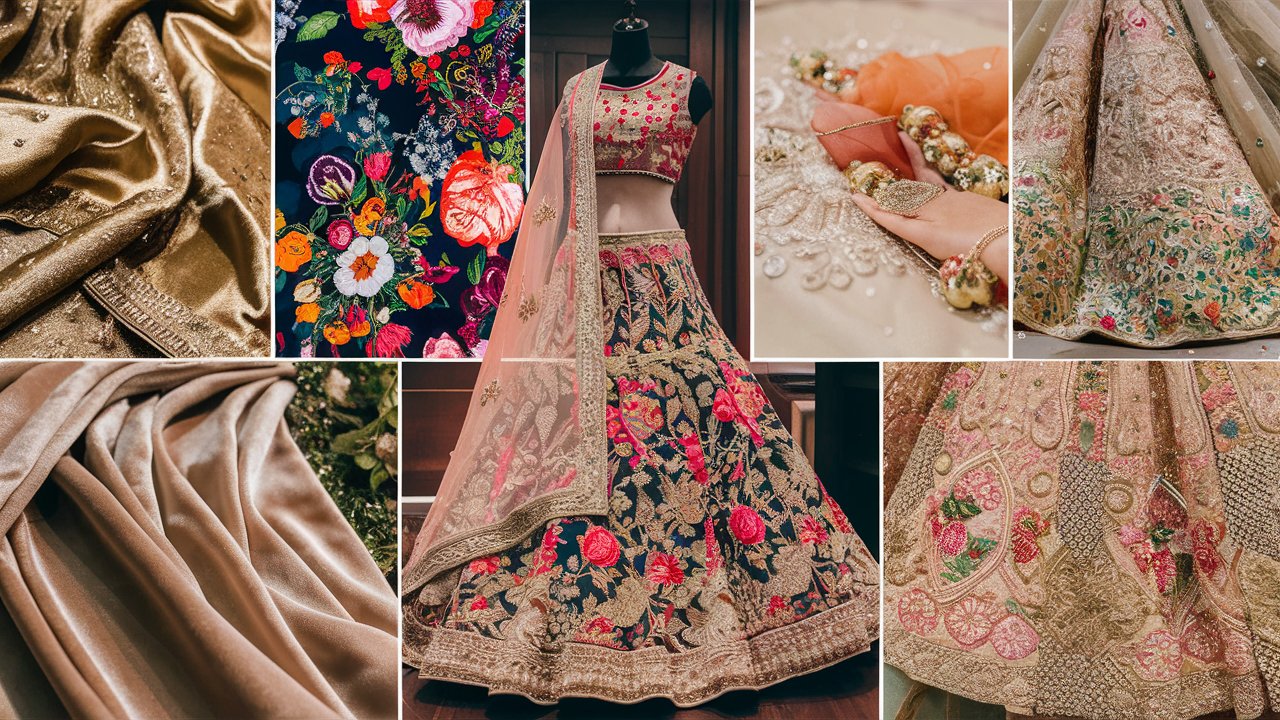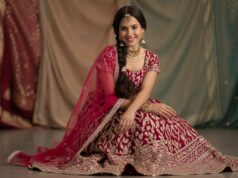Picture this: You’re standing in front of a mirror, draped in a stunning lehenga that makes you feel like royalty. 👑 The fabric flows gracefully, catching the light with every movement. But wait… what if you chose the wrong fabric? 😱 The horror of an uncomfortable, ill-fitting, or high-maintenance lehenga can turn your dream outfit into a nightmare.
Don’t let fabric confusion ruin your special day! Whether you’re planning for a wedding, festival, or grand celebration, choosing the right fabric for your lehenga is crucial. The options can be overwhelming, from traditional silk and brocade to modern alternatives like georgette and crepe. But fear not! We’re here to unravel the mystery of lehenga fabrics and help you make the perfect choice.
In this comprehensive guide, we’ll explore everything from time-honoured fabrics to contemporary favourites, factors to consider when selecting your lehenga material, and even delve into embellishments and fabric combinations. By the end, you’ll be a lehenga fabric expert, ready to choose the perfect ensemble that looks stunning feels comfortable and suits your unique style. Let’s dive in and discover which fabrics truly work best for lehengas! 🌟

Traditional Fabrics for Lehengas
A. Silk: The Timeless Classic
Silk has long been the go-to fabric for lehengas, offering a perfect blend of elegance and tradition. Its lustrous sheen and smooth texture create a luxurious look that’s hard to match. There are several types of silk used in lehengas:
- Banarasi silk: Known for intricate gold or silver zari work
- Kanchipuram silk: Renowned for its durability and rich colours
- Tussar silk: Offers a more textured, natural look
B. Brocade: Regal and Ornate
Brocade fabric adds a touch of royalty to lehengas with its raised patterns and metallic threads. It’s perfect for formal occasions and weddings. Key features of brocade include:
| Feature | Description |
|---|---|
| Texture | Rich, raised patterns |
| Durability | Sturdy and long-lasting |
| Appearance | Opulent and eye-catching |
C. Velvet: Luxurious and Elegant
Velvet lehengas exude sophistication and are ideal for winter weddings. The fabric’s plush texture and deep colours create a stunning visual impact. Velvet works well for:
- Full lehenga skirts
- Choli (blouse) designs
- Dupatta borders
D. Georgette: Light and Flowy
For those seeking a more contemporary look, georgette offers a lightweight and fluid option. It’s perfect for creating flowy silhouettes and is comfortable for all-day wear. Georgette lehengas are:
- Easy to drape
- Suitable for embroidery and embellishments
- Ideal for summer events
Each of these traditional fabrics brings its unique charm to lehengas, allowing brides and fashion enthusiasts to choose based on their preferences and the occasion.
Modern Fabric Choices
Now that we’ve explored traditional fabrics, let’s delve into the world of modern fabric choices for lehengas. These contemporary options offer a fresh take on this classic Indian garment, providing brides and fashion enthusiasts with exciting alternatives.
A. Chiffon: Ethereal and Graceful
Chiffon lehengas exude an ethereal charm, perfect for those seeking a light and airy look. This fabric drapes beautifully, creating a graceful silhouette that’s ideal for summer weddings or destination ceremonies.
B. Net: Delicate and Versatile
Net fabric offers a delicate and versatile option for lehengas. It can be layered to create depth and dimension, making it a popular choice for designers looking to craft unique, eye-catching pieces.
C. Crepe: Sleek and Comfortable
Crepe lehengas provide a sleek and comfortable option for the modern bride. This fabric’s smooth texture and excellent fall make it perfect for creating streamlined, contemporary designs.
D. Organza: Sheer and Voluminous
Organza brings a touch of drama to lehengas with its sheer and voluminous nature. It’s ideal for creating statement pieces with plenty of structure and movement.
E. Satin: Smooth and Shimmering
Satin lehengas offer a smooth and shimmering appearance, perfect for those who want to make a glamorous statement. This fabric reflects light beautifully, adding a touch of luxury to any design.
| Fabric | Characteristics | Best For |
|---|---|---|
| Chiffon | Light, airy, flowing | Summer weddings |
| Net | Delicate, layerable | Unique designs |
| Crepe | Smooth, comfortable | Modern, sleek looks |
| Organza | Sheer, structured | Dramatic styles |
| Satin | Smooth, shiny | Glamorous events |
These modern fabric choices offer a range of textures and effects, allowing for greater creativity in lehenga design. Next, we’ll explore the crucial factors to consider when selecting the perfect fabric for your lehenga.
Factors to Consider When Choosing Fabrics
Body Type and Silhouette
When selecting fabrics for your lehenga, it’s crucial to consider your body type and desired silhouette. Different fabrics drape and fall differently, affecting how they complement your figure.
| Body Type | Recommended Fabrics | Fabrics to Avoid |
|---|---|---|
| Pear-shaped | Silk, Georgette | Heavy Brocade |
| Hourglass | Brocade, Velvet | Stiff Organza |
| Apple-shaped | Chiffon, Crepe | Thick Satin |
| Petite | Lightweight Silk, Net | Heavy Embroidered |
Season and Weather
The climate plays a significant role in fabric selection. For summer weddings, opt for breathable fabrics that keep you cool, while winter celebrations call for warmer materials.
- Summer fabrics: Cotton, Organza, Chiffon
- Winter fabrics: Velvet, Brocade, Heavy Silk
Occasion and Formality
The event’s formality should guide your fabric choice. A grand wedding reception might call for luxurious fabrics, while a casual sangeet allows for more relaxed options.
Comfort and Wearability
Consider the weight and feel of the fabric against your skin. Remember, you’ll be wearing the lehenga for several hours, so comfort is key. Fabrics like silk and cotton blends offer both elegance and ease of movement, ensuring you can dance and celebrate with joy throughout the event.
Embellishments and Fabric Combinations
Embroidery-Friendly Fabrics
When it comes to creating stunning lehengas, embroidery plays a crucial role in elevating the overall design. Certain fabrics are particularly well-suited for intricate embroidery work:
- Silk
- Georgette
- Crepe
- Velvet
- Net
These fabrics provide a stable base for various embroidery techniques, allowing for detailed and durable designs.
Sequin and Bead Work Considerations
Sequins and beads add sparkle and glamour to lehengas, but not all fabrics can support their weight. Consider the following factors:
| Fabric Type | Suitability for Sequins/Beads | Durability |
|---|---|---|
| Raw Silk | Excellent | High |
| Net | Good | Medium |
| Chiffon | Fair | Low |
Choose fabrics that can withstand the weight of embellishments without compromising the drape or structure of the lehenga.
Mixing and Matching Fabrics for Unique Looks
Creating a one-of-a-kind lehenga often involves combining different fabrics. Here are some popular combinations:
- Silk skirt with a net dupatta
- Velvet blouse paired with a brocade skirt
- Georgette lehenga with a silk choli
Mixing fabrics allows for interesting textures and visual appeal. When combining fabrics, ensure they complement each other in terms of weight, drape, and overall aesthetic. This approach not only creates a unique look but also allows for versatility in styling and wearing the lehenga for different occasions.
Care and Maintenance
Cleaning Methods for Different Fabrics
Proper cleaning is essential for maintaining the beauty of your lehenga. Different fabrics require specific care:
| Fabric | Cleaning Method |
|---|---|
| Silk | Dry clean only |
| Cotton | Hand wash or gentle machine wash |
| Georgette | Dry clean or hand wash with mild detergent |
| Velvet | Professional dry cleaning |
Always check the care label and follow the manufacturer’s instructions.
Storage Tips to Preserve Lehenga Quality
To keep your lehenga in pristine condition:
- Store in a cool, dry place away from direct sunlight
- Use padded hangers to maintain shape
- Place acid-free tissue paper between folds to prevent creasing
- Cover with a breathable garment bag to protect from dust
Extending the Lifespan of Your Lehenga
To ensure your lehenga lasts for years:
- Rotate wear to prevent excessive stress on one area
- Address stains immediately to prevent the setting
- Avoid wearing heavy jewellery that may snag the fabric
- Handle embellishments with care, repairing loose beads or sequins promptly
By following these care and maintenance tips, you can keep your lehenga looking beautiful for many occasions to come. Remember, investing time in proper care will preserve the fabric’s quality and the garment’s overall appearance.
Choosing the right fabric for your lehenga is crucial to achieving the perfect look and comfort for your special occasion. From traditional options like silk and velvet to modern choices such as georgette and crepe, each fabric offers unique qualities that cater to different styles and preferences. When selecting your lehenga fabric, consider factors such as the event type, season, and style to ensure you make the best choice.
Remember that the fabric you choose will also impact the overall appearance of embellishments and the maintenance required for your lehenga. By understanding the characteristics of different fabrics and how they work with various designs and embellishments, you can create a stunning lehenga that not only looks beautiful but also stands the test of time. Whether you opt for a classic silk lehenga or a contemporary georgette ensemble, your fabric choice will play a significant role in making your outfit truly unforgettable.













[…] Necklaces: Perfect for lehengas with high or closed necklines, choker necklaces add a regal touch. They sit close to the neck and […]